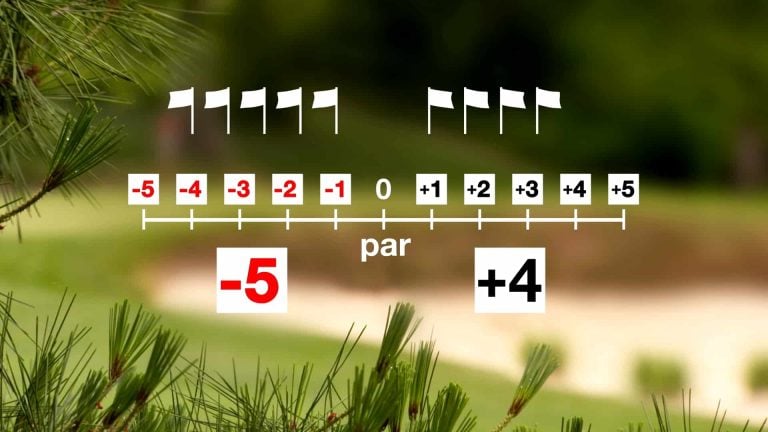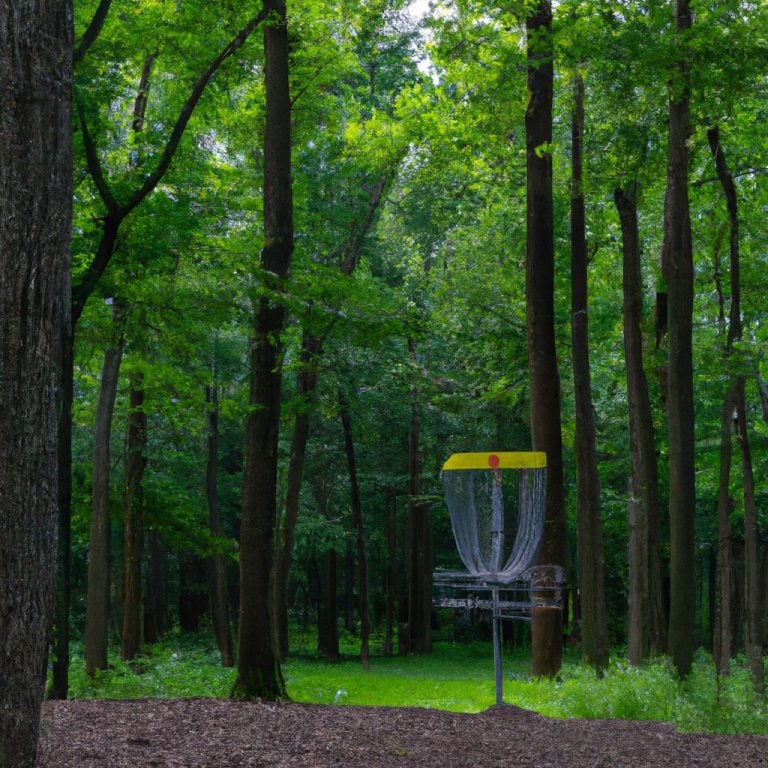Mastering the Course: Golf How to Read Greens Like a Pro
Key takeaways:
- Understanding the basics of green construction and drainage is crucial for effective green reading in golf.
- Before arriving at the putting surface, it is important to assess the tilt and slope of the green, as well as analyze the surrounding area and side slopes.
- Dividing longer putts into sections and using circles can help accurately determine the breaks on the greens.
- Adjusting the break and speed based on the severity of the tilt is essential for successful putting.
- Utilizing technology and green-reading aids, such as the GolfLogix app, can provide assistance in reading greens.
- Following Dave Stockton’s step-by-step guide can improve green-reading skills, including taking in the surroundings, dividing putts into thirds, and aligning the ball with the “new” center of the hole.
- Practicing Stockton’s techniques and visualizing the path of the putt can lead to better putt success rates.
- Making a confident putting stroke and committing to the chosen line is key for putting success.
- Improving green-reading skills can greatly increase putt success rates and overall performance on the greens.
The importance of green reading in golf
Green reading is a crucial aspect of golf that can greatly impact your success on the putting surface. In this section, we’ll explore the importance of understanding the basics of green construction and drainage, as well as the essential steps for preparing to read the green. By mastering these elements, you’ll be able to make more informed decisions and improve your putting game. So, let’s dive in and uncover the secrets to better green reading in golf.

Understanding the basics of green construction and drainage
Green construction and drainage are essential for building or renovating a golf green. Factors like selecting the right grass, creating contours, and a drainage system must be considered. This ensures a smooth roll and draining of any excess water.
Drainage is key in preserving the green’s integrity. Too much water can cause soggy conditions, affecting the ball’s movement and consistency. Understanding drainage helps golfers predict how moisture will influence their putts and act accordingly.
Knowledge of tilt and surrounding area side slopes is essential. Tilt helps decide the break of the putt due to gravity. Analyzing the slopes shows how they can influence the rolls.
By understanding these basics, golfers can read greens better. This enables them to adjust their aim, speed, and technique to improve their chances of getting a hole-in-one.
Technology and aids can also help. For example, the GolfLogix app provides mapping information about contours from thousands of courses. This allows golfers to know the breaks before they even reach the course.
Therefore, green construction and drainage are key for a successful putt. By understanding these fundamentals, golfers can outsmart Mother Nature’s tricky green designs.
Preparing to read the green before arriving at the putting surface
Preparing to read the green before arriving at the putting surface is key in golf. Assess the tilt and slope of the green to determine the trajectory of your ball. Understand these factors to analyze the area and side slopes. This will give you info on how the ball will break when hit.
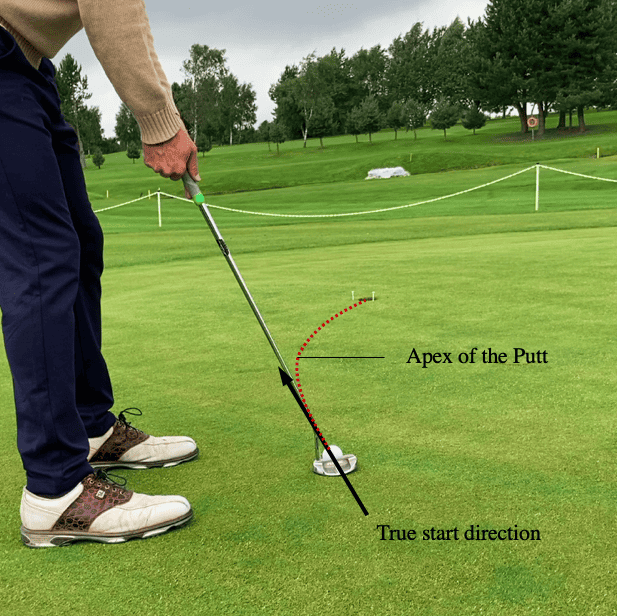
Divide longer putts into sections to analyse each break. Use circles and walk around shorter putts to get a sense of the tilt and slope. Adopt a wide stance to identify the higher side of the intended line. This can help adjust your aim.
Adjust both break and speed depending on the severity of tilt. Knowing how much the green tilts can help make educated decisions. This includes considering if you need to hit the ball harder or softer and adjusting your angle for accuracy.
Technology and green-reading aids have become popular for golfers seeking assistance. For example, the GolfLogix app provides an overview of courses’ greens and helpful features like slope measurements and maps.
Dave Stockton has a step-by-step guide for green-reading. Start by taking in surroundings and feeling the texture of the green. Then analyze each putt from a low perspective. Divide it into thirds for a thorough assessment. Find a new center alignment point based on your analysis. Finally, focus one inch in front of the ball when putting.
Practice regularly to master green-reading techniques. Visualize the path of the putt and align it with your chosen line after careful assessment. Commit to this line and make confident putting strokes. This can help improve your green-reading skills and increase success rates on the course.
Assessing the tilt and slope of the green
Playing golf needs a great understanding of the land. A key aspect is estimating the tilt and slope of the green. This involves judging the angle and incline of the putting surface before shooting. By studying these factors, you can guess how your ball will roll and change your aim and stroke.
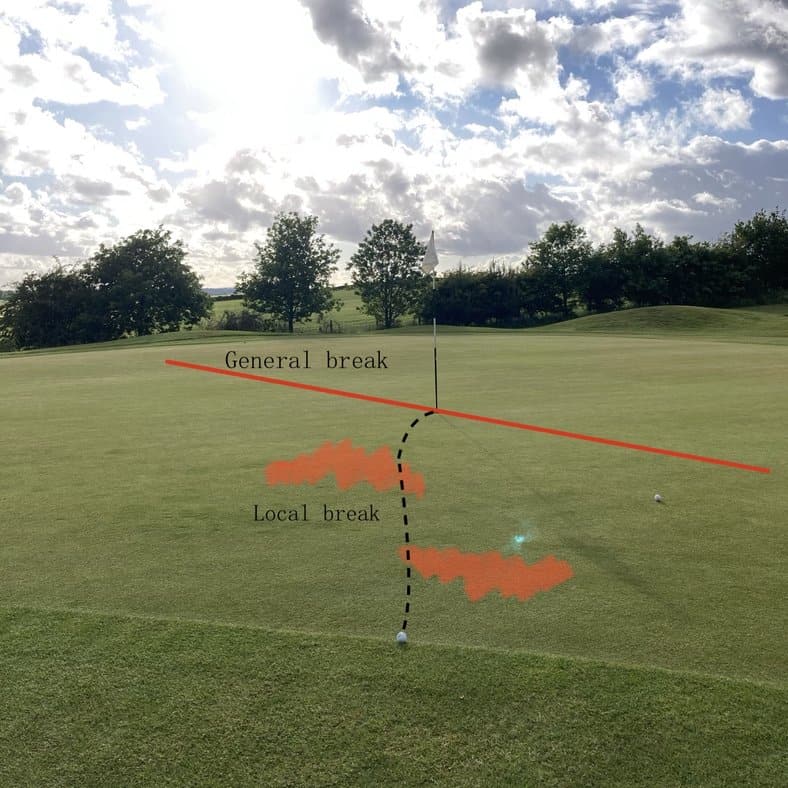
To rate the tilt and slope of the green, use this 6-step guide:
- First, observe the overall shape of the green. Look for any slopes or hills that may affect the path of your putt.
- Get closer to the green for a more detailed view. Note any slight breaks in different areas of the putting surface.
- Kneel down for a closer look at the green from a lower angle. This can help you find small slope changes that may influence your putt.
- Walk around the edges of the green to analyze it from multiple sides. This will give you a better understanding of its overall topography and potential issues.
- Notice any features around the green like bunkers, water hazards, or rough spots. These can also affect how your ball will react on the green.
- Consider factors like wind speed and direction, as they can further influence how much break you should expect when measuring the tilt and slope.
Assessing the tilt and slope is important for every golfer, but certain details may vary depending on playing style and level of experience. For instance, experienced players may be better at spotting subtle breaks on greens with different speeds or surfaces with more undulations.
To improve your skills in assessing tilt and slope, try these tips:
- Play on different courses with varying degrees of difficulty. This practice will help you learn to adapt to different conditions.
- Ask experienced golfers or instructors who are good at reading greens.
- Use tech aids, like slope-reading devices or apps, to assess the tilt and slope more accurately.
- Watch how your putts react to different slope angles during practice rounds. This will give you useful firsthand experience understanding green dynamics.
If you use these tips when assessing the tilt and slope of the green, you can develop your reading skills and make smarter decisions during your golf rounds. This will increase your rate of successful putts and better your overall performance on the course.
Analyzing the surrounding area and side slopes
Analyzing the area and side slopes on a golf green is essential for reading greens accurately. Golfers can assess the topography of the green and its surroundings to figure out how the ball will break. This helps them adjust their putting strategy.
- To get a better understanding of breaks, divide the green into sections – Golfers can split the green into smaller sections to see the breaks and slopes. This helps them make exact calculations when determining the line of their putt.
- Recognize side slopes to know the break direction – Analyzing the side slopes helps golfers find out which way their putt will break. It helps with their decision-making process.
- Observe surrounding obstacles for break assessment – Noting any obstacles or structures near the green gives more data about potential breaks or influences on the ball. Consider these when analyzing the slope and tilt of the green.
- Account for both uphill and downhill gradients – Assessing both gradients is vital for reading greens accurately. Uphill putts usually break less, downhill putts tend to have bigger breaks due to gravity.
- Look out for transitions between different grass types – Different grass types can change how a ball rolls, affecting its trajectory and break. Golfers should observe any transitions between different grass types to make better predictions.
Take into account weather conditions that may affect side slope analysis. Wind speed and direction, rain, and moisture on the green can influence how a putt breaks. Adjustments may be needed based on these factors.
John neglected to analyze the surroundings and side slopes while reading a putt. He didn’t notice a subtle side slope, and missed out on a birdie. He learned from this mistake and now pays attention to the surroundings and side slopes to make better decisions.
Use these techniques to read those tricky breaks on longer putts!
Techniques for accurately reading breaks on longer putts
Techniques for accurately reading breaks on longer putts – Learn how to divide longer putts into sections for precise break assessment, utilize circles and walk around shorter putts to sense tilt, and establish a wide stance behind the ball to determine the higher side of the line. Mastering these techniques can significantly improve your green-reading skills and help you sink those challenging putts with confidence.

Dividing longer putts into sections for precise break assessment
Divide long putts into sections for precise break evaluation! Here’s how:
- Stand behind the ball and imagine the path from the aim point to the hole.
- Split the length into two or three pieces.
- Mentally assess each section – check for slopes and contours that could influence the break.
- Analyze how the sections will affect the speed & direction of the putt.
- Adjust aim point based on assessment of each break – consider both directions & intensity.
- Walk around and check each section from different angles before attempting the putt.
Golfers can make a more precise assessment of the breaks on the green by dividing longer putts into sections. This method helps plan the approach to sinking long putts successfully – accounting for slopes & tilt.
Pro Tip: Practice these techniques regularly – develop an instinctive understanding of various greens.
Utilizing circles and walking around shorter putts to sense tilt
Golfers can use circles and walking around shorter putts to sense tilt and get an overall view of the green’s slope and contours. This helps them to make better decisions when reading breaks and adjusting aim and speed.

By walking around, golfers can look for any subtle breaks or deviations that may affect how the ball rolls. Taking the time to observe the green from different angles gives them a better idea of the topography before their shot.
These techniques can enhance golfers’ green-reading skills. By using circles and walking around, they can get insight into the tilt of the green. This enables them to make more accurate assessments and adjustments.
In summary, utilizing circles and walking around shorter putts is essential for golfers who want to improve their green-reading skills. It provides valuable information for accurately reading breaks and improving their overall putting performance. So, widen your stance and use circles and walking around to sense tilt for improved performance on the green.
Wide stance behind the ball to determine higher side of the line
Golfers use a wide stance when they are behind the ball. This helps them determine which side of the green is higher. It allows them to work out which way the ball will break when they putt.
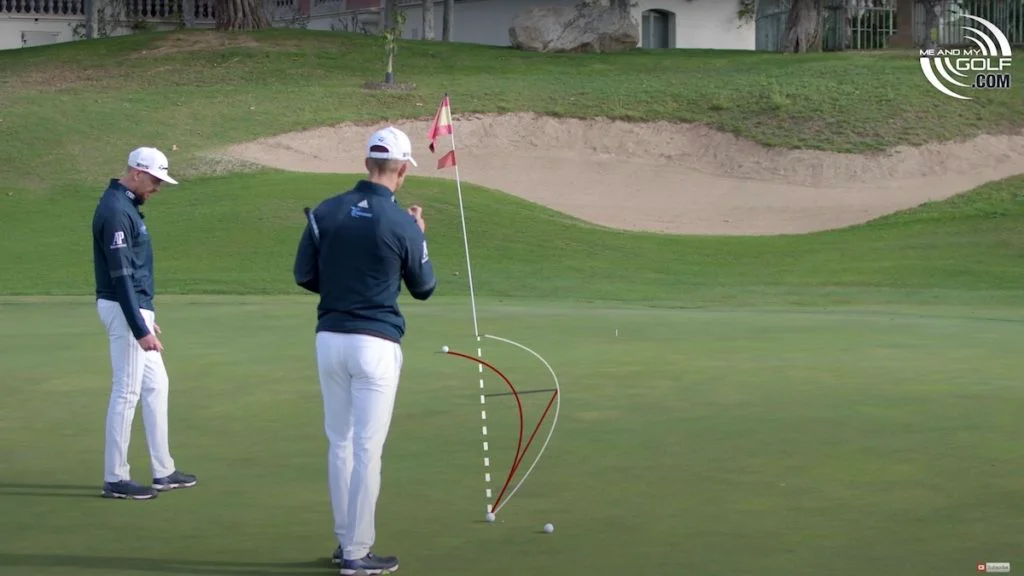
The wide stance gives stability and helps golfers to spot any changes in elevation or tilt that could affect their putt. They can also spot any obstacles that may influence their putting line.
By taking a wide stance and looking at the green and its surroundings, golfers can read the breaks better. This technique improves their putting performance.
Adjusting break and speed based on the severity of the tilt
To putt accurately on varying greens, practice and experience are key. Assess the tilt on the green and range from subtle to sharp. Adjust the break depending on severity. Adapt ball speed for the incline. Read the slope and make the necessary changes for a successful putt.

The benefits of improving green-reading skills and increasing putt success rates
Golfers can reap significant rewards by honing their green-reading skills and upping putt success rates. They can accurately assess the slopes, breaks, and undulations of the putting surface. This sharpened skill leads to better decisions and more accurate putts, resulting in fewer strokes per round.
- Better Decision-Making: Golfers can make more informed decisions about putt direction and speed, increasing the chances of sinking them.
- Improved Putting Accuracy: By reading the greens properly, golfers can focus on landing the ball on the desired path, reducing missed holes.
- Fewer Putts: Improved green-reading skills let golfers anticipate the breaks and slopes accurately, helping them select the right line, resulting in fewer putts per hole.
- Competitive Edge: Golfers who have developed their green-reading abilities have a better chance of making successful putts, giving them an advantage in match or stroke play.
- Lower Scores: More putts in the hole means lower scores as golfers become better at converting opportunities into made putts.
- Enhanced Confidence: Improved green-reading skills boost a golfer’s mental game and self-belief, leading to superior performance and enjoyment on the course.
Plus, mastering green-reading skills provides a clearer understanding of the course. Golfers can consider the slopes and grain direction, aiding their approach shots and playing strategy.
Developing green-reading skills and increasing putt success rates also strengthens the connection between the golfer and the game. By grasping these skills, players become more attuned to the nuances of putting surfaces, which increases appreciation and enjoyment for the sport.
To illustrate, John, a passionate golfer, was struggling with poor putting performance until he spent time studying and honing his green-reading abilities. After hours of practice, John’s success rates soared, leading to lower scores and confidence in his putting game. Now, John strategically and analytically approaches each putt, resulting in superior performance on the course.
Mastering the art of green-reading and improving putt success rates take time and effort. However, the rewards are worth it, leading to lowered scores, increased confidence, and greater satisfaction with the sport.
Some Facts About Golf How to Read Greens:
- ✅ Reading greens is just as important as having a perfect putting stroke in golf. (Source: golfguidebook.com)
- ✅ Assessing the slope of the putt is crucial for getting the correct speed. (Source: golfguidebook.com)
- ✅ Walking around your putt can provide valuable information about the green. (Source: golfguidebook.com)
- ✅ Long putts may have more than one break and require more focus on the second half. (Source: golfguidebook.com)
- ✅ Dave Stockton, a legendary putter, has shared his 5-step fix for improving green-reading skills in a Golf Digest Schools series. (Source: golfdigest.com)
FAQs about Golf How To Read Greens
How does the line reading procedure help in improving green reading skills?
The line reading procedure involves assessing the break, slope, and potentially the grain of the grass on the green. By carefully studying these factors, golfers can get a more accurate read on the putt, which helps them determine the appropriate speed and direction to hit the ball.
What are some tips for golfers struggling with their putting?
Golfers who struggle with their putting can focus on a few key areas to improve their performance. Controlling distance and speed should be a top priority, as well as reading the tilt and breaks of the green more accurately. Taking small circles on shorter putts can help feel the subtle tilt, while standing with a wide stance directly behind the ball can indicate which side of the line is higher.
How can learning how to read greens have a positive impact on a golfer’s game?
Learning how to read greens is just as important as having a perfect putting stroke in golf. By accurately assessing the break, slope, and grain of the grass on the green, golfers can make more informed decisions about their putt. This can significantly improve their chances of hitting the ball on the intended line and ultimately sinking more putts.
What are the key steps in Dave Stockton’s green reading process?
Dave Stockton, a legendary putter, recommends a 5-step process for improving green reading skills. The steps include taking in the surroundings and feeling the green with your feet, reading the putt from the low side to understand the break, dividing the putt into thirds for a more detailed read, finding the “new” center of the hole from behind, and focusing one inch in front of the ball to minimize distractions and improve concentration.
How can technology assist golfers in their green reading process?
Technology, such as the GolfLogix app, can provide valuable assistance in the green reading process. These applications offer features that help golfers assess the break, slope, and other factors on the green. By utilizing such tools, golfers can enhance their understanding of the green and make more accurate predictions for their putts.
What are the benefits of practicing green reading skills?
Practicing green reading skills can lead to improved performance on the golf course. By honing these skills, golfers can save more strokes by hitting the ball on the intended line and avoiding unnecessary putts. Additionally, practicing green reading can boost confidence, increase focus, and allow golfers to make better decisions based on the intricacies of each green.




